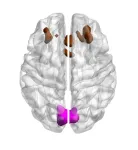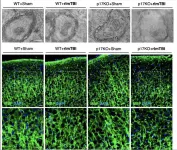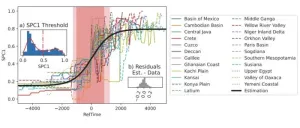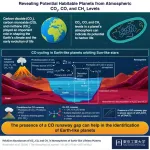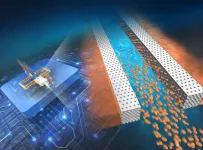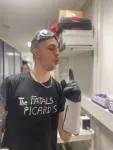(Press-News.org) While wind farms have become a widely popular method of generating energy, researchers are now looking at the impact of these large farms on wind patterns and the surrounding environment.
Using large-scale simulations to better understand the way air moves across and within wind farms, researchers from UBC Okanagan and Delft University of Technology (TU Delft) in the Netherlands have developed a modelling framework that will help improve wind energy forecasts and productivity.
The researchers also hope to learn how large wind farms can alter natural wind patterns.
“Wind farms are getting so large that they can actually alter the structure of the incoming wind,” explains Dr. Joshua Brinkerhoff, an Associate Professor in UBCO’s School of Engineering.
“The structure they are researching, which engineers call the atmospheric boundary layer, monitors how the wind’s speed, temperature and pressure varies with altitude.”
Not only is locating where to put a wind farm a science in itself, he explains, but fine-tuning the location of individual turbines within a grouping is paramount to power output. While software helps guide the placement of the turbines to ensure the highest yield, poorly designed wind farms will generate less power than expected, making the wind farm uneconomical.
“Our modelling framework is among the first to clearly describe how wind farms alter the atmospheric boundary layer, which makes it tremendously valuable in helping engineers design better wind farms,” says Dr. Brinkerhoff.
Working alongside colleagues from TU Delft, doctoral student Sebastiano Stipa travelled to the Netherlands as part of a Mitacs Globalink exchange to conduct the research. The research team has developed an open-source, finite-volume framework tailored for large-scale studies of how wind farms interact with the atmosphere.
The modelling framework, called the Toolbox for Stratified Convective Atmospheres (TOSCA), is designed to conduct extensive simulations of the turbulence created by big wind farms in realistic atmospheric conditions. The paper outlining TOSCA was published this week in Wind Energy Science.
TOSCA, explains Stipa, can address at least two of the significant challenges currently facing wind energy by simulating boundary layer turbulence over large areas and the simulation of an entire wind farm under realistic atmospheric flow conditions.
“The results of this research will lead to a better understanding of potential wind farm power estimates and an increase in their energy outputs,” says Stipa. “This new modelling framework can serve as a roadmap for the industry.”
Dr. Brinkerhoff notes the computer modelling can help when wind farms are being established, especially to forecast whether they can create energy efficiently.
“The most significant finding is that our model can capture the interaction between large wind farms and the oncoming wind,” he adds. “To date, this hasn’t been captured properly, leading to overestimation of how much power a wind farm will produce. This kind of overestimation is financially disastrous for the wind farm operators.”
This research was supported by Mitacs Globalink, UL Renewables and the Natural Science and Engineering Research Council of Canada. Computational resources were provided by the Digital Research Alliance of Canada and Advanced Research Computing at the University of British Columbia.
END
Powerful answers to energy questions may be blowing in the wind
UBC Okanagan researchers study how wind farms can change airstream patterns
2024-02-06
ELSE PRESS RELEASES FROM THIS DATE:
Discover BMB announces exciting lineup of speakers
2024-02-06
Be front and center for the hottest research findings in the molecular life sciences at Discover BMB, the annual meeting of the American Society for Biochemistry and Molecular Biology, to be held March 23–26 in San Antonio.
Don’t miss this opportunity to hear from the top minds in the field. Reporters are invited to register for a complimentary press pass to attend #DiscoverBMB in San Antonio or access press materials electronically. Please note that only a limited number of complementary on-site press passes will be issued, so advance registration is recommended. Find more information in the #DiscoverBMB newsroom.
As part of an exciting program spotlighting the ...
Study finds strongest evidence to date of brain’s ability to compensate for age-related cognitive decline
2024-02-06
Scientists have found the strongest evidence yet that our brains can compensate for age-related deterioration by recruiting other areas to help with brain function and maintain cognitive performance.
As we age, our brain gradually atrophies, losing nerve cells and connections and this can lead to a decline in brain function. It’s not fully understood why some people appear to maintain better brain function than others, and how we can protect ourselves from cognitive decline.
A widely accepted notion is that some people’s brains are able to compensate ...
How T cells combat tuberculosis
2024-02-06
LA JOLLA, CA—La Jolla Institute for Immunology (LJI) is working to guide the development of new tuberculosis vaccines and drug therapies.
Now a team of LJI scientists has uncovered important clues to how human T cells combat Mycobacterium tuberculosis, the bacterium that causes TB. Their findings were published recently in Nature Communications.
"This research gives us a better understanding of T cell responses to different stages in tuberculosis infection and helps us figure out is there are additional diagnostic ...
Drug could protect brains from damage after concussions
2024-02-06
Repeat concussions, also referred to as repetitive mild traumatic brain injury, can lead to chronic traumatic encephalopathy (CTE) and raise the risk of Alzheimer’s disease. However, some people who experience repetitive mild traumatic brain injury never develop major disease. Onder Albayram and colleagues investigated the role of a protein known as p17 in protecting brains from long-term pathologies. In stressed neurons, p17 initiates production of C18-Ceramide, a bioactive sphingolipid that acts as a label of damaged mitochondria in neuronal axons. Labelled mitochondria are then detected and removed by autophagosomes. The authors knocked out p17 in mice. Some p17-knockout ...
Is there a typical rate of cultural evolution?
2024-02-06
Are cultural evolution rates similar across human societies? The emerging field of Cliodynamics uses mathematical models to study history. Tobias Wand and colleagues used a data-driven approach to estimate the rates of cultural evolution in 23 geographic areas, using data from Seshat: Global History Databank, which records nine “complexity characteristics” for 370 polities over 10,000 years, ending in the nineteenth century. The complexity characteristics are polity population; extent of polity territory; the size of the largest urban center; hierarchical complexity; the ...
Last chance to get hotel discounts for the world’s largest physics meeting
2024-02-06
Next month, scientists from around the world will convene to share new results from across the physical sciences in nearly 11,000 individual presentations. The American Physical Society’s (APS) March Meeting will be held in person in Minneapolis and online everywhere March 3-8.
Discounted hotel rates are available for in-person attendees at select Minneapolis hotels near the Minneapolis Convention Center. Book your hotel by Feb. 9 to receive the discount.
Press Registration
News media with valid APS press credentials may register for the meeting at no cost. To request press credentials, visit APS’s online newsroom. Registration ...
Newly discovered carbon monoxide-runaway gap can help identify habitable exoplanets
2024-02-06
The search for habitable exoplanets involves looking for planets with similar conditions to the Earth, such as liquid water, a suitable temperature range and atmospheric conditions. One crucial factor is the planet's position in the habitable zone, the region around a star where liquid water could potentially exist on the planet's surface. NASA's Kepler telescope, launched in 2009, revealed that 20–50% of visible stars may host such habitable Earth-sized rocky planets. However, the presence of liquid water alone does not guarantee a planet’s habitability. On Earth, ...
Pore power: high-speed droplet production in microfluidic devices
2024-02-06
Over the past two decades, microfluidic devices, which use technology to produce micrometer-sized droplets, have become crucial to various applications. These span chemical reactions, biomolecular analysis, soft-matter chemistry, and the production of fine materials. Furthermore, droplet microfluidics has enabled new applications that were not possible with traditional methods. It can shape the size of the particles and influence their morphology and anisotropy. However, the conventional way of generating droplets in a single microchannel structure is often slow, ...
How a city is organized can create less-biased citizens
2024-02-06
The city you live in could be making you, your family, and your friends more unconsciously racist. Or, your city might make you less racist. It depends on how populous, diverse, and segregated your city is, according to a new study that brings together the math of cities with the psychology of how individuals develop unconscious racial biases.
The study, published in the latest issue of Nature Communications, presents data and a mathematical model of exposure and adaptation in social networks that can help explain why there is more unconscious, or implicit, racial bias ...
Reversible deformation, permanent fabric development
2024-02-06
6 February 2024
The Geological Society of America
Release No. 24-01
Contributed by Arianna Soldati, GSA Science Communication Fellow
Boulder, Colo., USA: Earth is a stressed planet. As plates move, magma rises, and glaciers melt—just to mention a few scenarios—rocks are subject to varying pressure and compressional and extensional forces. The effect of these stresses on rock mineralogy and texture is of great interest to the tectono-metamorphic community. Yet the link between process and outcome remains elusive.
There are two possible states of stress: either all principal ...
LAST 30 PRESS RELEASES:
58% of patients affected by 2022 mpox outbreak report lasting physical symptoms
Golden Gate method enables rapid, fully-synthetic engineering of therapeutically relevant bacteriophages
Polar weather on Jupiter and Saturn hints at the planets’ interior details
Socio-environmental movements: key global guardians of biodiversity amid rising violence
Global warming and CO2 emissions 56 million years ago resulted in massive forest fires and soil erosion
Hidden order in quantum chaos: the pseudogap
Exploring why adapting to the environment is more difficult as people age
Society for Laboratory Automation and Screening welcomes new scientific director: Madeline M. Farley, Ph.D.
Austrian cow shows first case of flexible, multi-purpose tool use in cattle
Human nasal passages defend against the common cold and help determine how sick we get
Research alert: Spreading drug costs over the year may ease financial burden for Medicare cancer patients
Hospital partnership improves follow up scans, decreases long term risk after aortic repair
Layered hydrogen silicane for safe, lightweight, and energy-efficient hydrogen carrier
Observing positronium beam as a quantum matter wave for the first time
IEEE study investigates the effects of pointing error on quantum key distribution systems
Analyzing submerged fault structures to predict future earthquakes in Türkiye
Quantum ‘alchemy’ made feasible with excitons
‘Revoice’ device gives stroke patients their voice back
USF-led study: AI helps reveal global surge in floating algae
New method predicts asthma attacks up to five years in advance
Researchers publish first ever structural engineering manual for bamboo
National poll: Less than half of parents say swearing is never OK for kids
Decades of suffering: Long-term mental health outcomes of Kurdish chemical gas attacks
Interactional dynamics of self-assessment and advice in peer reflection on microteaching
When aging affects the young: Revealing the weight of caregiving on teenagers
Can Canada’s health systems handle increased demand during FIFA World Cup?
Autistic and non-autistic faces may “speak a different language” when expressing emotion
No clear evidence that cannabis-based medicines relieve chronic nerve pain
Pioneering second-order nonlinear vibrational nanoscopy for interfacial molecular systems beyond the diffraction limit
Bottleneck in hydrogen distribution jeopardises billions in clean energy
[Press-News.org] Powerful answers to energy questions may be blowing in the windUBC Okanagan researchers study how wind farms can change airstream patterns
